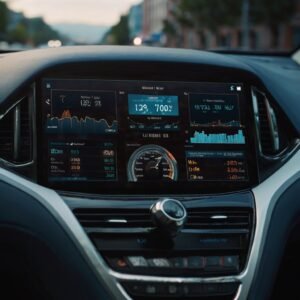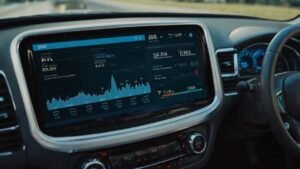Introduction
As we enter 2025, the landscape of car insurance is undergoing a significant transformation. With rising costs and changing consumer needs, drivers are increasingly looking for innovative solutions to manage their insurance expenses. One of the most compelling trends in this arena is the rise of pay-per-mile car insurance. This model offers a unique approach to insurance, allowing drivers to pay based on the actual miles they drive rather than a flat annual premium.
In a world where many individuals are seeking ways to save money, especially in light of economic pressures and rising living costs, pay-per-mile insurance has emerged as a viable option for many. But the question remains: Is pay-per-mile insurance cheaper than traditional car insurance in 2025? This article will explore the mechanics of pay-per-mile insurance, analyze real driver experiences, and provide a thorough cost comparison to help you determine if this insurance model is the right choice for you.
What is Pay-Per-Mile Car Insurance?
Pay-per-mile car insurance is a usage-based insurance model that calculates premiums based on the actual number of miles driven. Unlike traditional car insurance, which typically relies on a fixed rate determined by factors such as age, driving history, and vehicle type, pay-per-mile insurance offers a more personalized approach tailored to individual driving habits.
How It Works
The mechanics of pay-per-mile insurance are relatively straightforward. When a driver opts for this insurance model, they generally pay a base rate for coverage, which covers their vehicle regardless of usage. Additionally, they are charged a fee for every mile driven. For instance, a driver might pay a base monthly premium of $20 and an additional $0.05 for every mile driven. This structure is particularly beneficial for individuals who do not use their vehicles frequently, allowing them to save on insurance costs.
Telematics Technology
At the core of pay-per-mile insurance lies telematics technology. Insurers use devices or mobile applications to track mileage and driving behavior. This data enables insurance companies to assess risk more accurately and adjust premiums based on actual driving patterns. While the use of telematics raises privacy concerns for some drivers, many find the potential savings worthwhile, especially if they drive less than average. Furthermore, telematics can provide valuable insights into driving habits, allowing drivers to improve their safety on the road.

The Rise of Pay-Per-Mile Insurance
The popularity of pay-per-mile insurance has surged in recent years, driven by a combination of factors that resonate with contemporary consumers.
Changing Consumer Preferences
As consumers become more cost-conscious, they are increasingly seeking flexible insurance options that align with their actual usage. The traditional insurance model, with its one-size-fits-all approach, often leads to overpayment for those who drive infrequently. According to a recent survey conducted by the Insurance Information Institute, approximately 30% of drivers expressed interest in switching to a pay-per-mile insurance model, underscoring a shift in consumer sentiment toward more personalized and usage-based coverage.
Economic Factors
Economic pressures, including rising living costs and inflation, have further fueled the demand for pay-per-mile insurance. As individuals and families seek ways to cut expenses, finding savings on insurance becomes paramount. Pay-per-mile insurance presents a viable solution for those whose driving habits align with this model. For instance, a young professional who commutes to work using public transportation but occasionally drives for errands can significantly benefit from a pay-per-mile plan.
Technological Advancements
The rapid advancement of technology has made it easier for insurance companies to implement and offer pay-per-mile models. Enhanced tracking capabilities and data analytics enable insurers to assess risk more accurately, ensuring that customers receive fair pricing based on their actual driving behavior. The integration of telematics not only allows for precise mileage tracking but also opens the door to innovative pricing structures that appeal to cost-conscious consumers. As smartphones become ubiquitous, many providers have developed apps that help customers monitor their driving habits and calculate their premiums in real-time.
Real Driver Experiences
To better understand the impact of pay-per-mile insurance, it’s essential to consider real driver experiences. These narratives provide valuable insights into the practical implications of this insurance model.
Case Study 1: Sarah’s Savings
Sarah, a freelance graphic designer, rarely drives her car. On average, she logs about 5,000 miles a year, primarily using her vehicle for local errands and occasional trips. Previously, she paid an annual premium of $1,200 for traditional insurance, regardless of her driving habits. After researching her options, Sarah decided to switch to a pay-per-mile insurance plan. With a base monthly rate of $20 and a per-mile cost of $0.05, her total annual cost dropped to around $600. Sarah exclaimed, “I never thought I could save so much! Now, I only pay for what I use, and it feels fair.” Her experience highlights how pay-per-mile insurance can provide significant savings for low-mileage drivers.
Case Study 2: Mike’s Disappointment
In contrast, Mike, a sales representative, drives approximately 20,000 miles a year as part of his job. He was initially drawn to the idea of pay-per-mile insurance, believing it would be a cost-effective option. However, after switching to a pay-per-mile plan with a base rate of $30 and a per-mile charge of $0.10, he found himself paying significantly more than expected. His total annual cost reached nearly $2,400. “I didn’t realize how much I would end up paying per mile. It just didn’t make sense for someone who drives as much as I do,” he explained. Mike’s experience serves as a reminder that pay-per-mile insurance may not be suitable for everyone, particularly high-mileage drivers.
Case Study 3: The Family Perspective
Consider the Johnsons, a family of four with two teenagers who recently acquired their first cars. They drive a combined total of 15,000 miles a year, primarily for school and weekend activities. Initially, opting for a traditional insurance plan, they found the costs to be prohibitive. After switching to a pay-per-mile insurance model, they paid a base rate of $25 per month plus $0.06 per mile. Their annual cost was significantly reduced to about $1,020. “We were shocked at how much we saved,” said Mrs. Johnson. “It allowed us to allocate funds toward our kids’ education instead.” This example illustrates how families with multiple drivers can also benefit from pay-per-mile insurance.
These contrasting experiences highlight the importance of evaluating individual driving habits and calculating potential costs before making the switch to pay-per-mile insurance.
Cost Comparison: Pay-Per-Mile vs. Traditional Insurance
When assessing whether pay-per-mile insurance is cheaper, conducting a thorough cost comparison is essential.
Average Costs
In the United States, the average annual premium for traditional car insurance is around $1,500. However, this figure varies widely based on factors such as location, driving history, and vehicle type. In contrast, pay-per-mile insurance typically features a base rate ranging from $20 to $30 per month, plus a per-mile charge that can vary between $0.05 and $0.10.
Hypothetical Scenarios
Let’s analyze three hypothetical scenarios to see how costs might compare for different driving habits:
1. **Low-Mileage Driver (5,000 miles/year)**
– **Traditional Insurance:** $1,500
– **Pay-Per-Mile Insurance:** $240 (base rate) + $0.05/mile x 5,000 miles = $600
– **Total Savings:** $900
2. **Moderate-Mileage Driver (15,000 miles/year)**
– **Traditional Insurance:** $1,500
– **Pay-Per-Mile Insurance:** $240 (base rate) + $0.07/mile x 15,000 miles = $990
– **Total Savings:** $510
3. **High-Mileage Driver (25,000 miles/year)**
– **Traditional Insurance:** $1,500
– **Pay-Per-Mile Insurance:** $240 (base rate) + $0.10/mile x 25,000 miles = $2,740
– **Total Costs:** $2,740 (this is higher than traditional insurance)
– **Total Difference:** $1,240 more expensive
From these scenarios, it is evident that pay-per-mile insurance can offer substantial savings for low-mileage drivers, while high-mileage drivers may find it more expensive than traditional insurance. This highlights the importance of understanding individual driving habits and calculating potential costs before making a decision.
Factors Influencing Costs in 2025
Several factors will influence the cost of car insurance in 2025, particularly for pay-per-mile models.
Economic Conditions
As the economy continues to fluctuate, factors like inflation and rising fuel prices can impact insurance premiums. Insurance companies may adjust their pricing models based on market conditions. If driving becomes more expensive due to high fuel prices, this could lead to increased premiums across the board. Additionally, economic downturns may result in more drivers opting for budget-friendly insurance options, thereby increasing competition among insurers.
Driving Behavior
As more individuals return to pre-pandemic driving habits, the demand for car insurance may increase. A rise in the number of drivers on the road could lead to higher accident rates, resulting in increased premiums for all drivers. Insurance companies may also adjust their rates based on the overall risk associated with increased driving. Furthermore, the rise of remote work arrangements may alter driving patterns, leading to varied insurance needs.
Regulatory Changes
Changes in state and federal regulations can also significantly affect insurance costs. For instance, if new regulations are implemented that require more extensive coverage or higher minimum liability limits, insurance companies may adjust their pricing models accordingly. Staying informed about regulatory changes is vital for consumers to understand how they may impact their premiums.
Technological Advances
The continued evolution of telematics and data analytics will likely play a significant role in shaping the future of pay-per-mile insurance. Enhanced data collection methods may allow insurers to offer more personalized premiums while also improving risk assessment. As technology continues to advance, we can expect to see even more innovative pricing models that cater to individual drivers’ needs.
Environmental Considerations
As discussions around climate change and environmental impact intensify, insurance companies may begin to consider environmental factors when pricing premiums. Drivers who opt for electric or hybrid vehicles might receive discounts, while those who drive larger, gas-guzzling vehicles could face higher rates. This shift could encourage more environmentally friendly driving habits and vehicle choices.
Advantages of Pay-Per-Mile Insurance
Several advantages make pay-per-mile insurance an attractive option for many drivers:
1. **Cost Savings for Low-Mileage Drivers**: As highlighted in the driver experiences section, those who drive less can save significantly with pay-per-mile insurance. This model allows them to pay only for the coverage they truly need, making it an economical choice.
2. **Flexibility**: Pay-per-mile insurance provides flexibility, allowing drivers to adjust their coverage based on their usage. This means that they are not locked into a fixed premium that doesn’t reflect their driving habits. Drivers can choose to increase or decrease their coverage based on their anticipated mileage.
3. **Encouragement of Safe Driving**: Drivers may be more mindful of their mileage and driving behavior, which can lead to safer driving practices and potentially lower accident rates. The knowledge that their insurance costs are tied to their driving habits may encourage improved safety on the road. Additionally, some insurers may offer safe driving discounts for those who demonstrate responsible driving behavior.
4. **Environmental Benefits**: By encouraging drivers to use their vehicles less, pay-per-mile insurance may contribute to reduced carbon emissions and less traffic congestion. This aligns with broader societal goals of promoting sustainability and reducing the environmental impact of transportation. As more consumers become environmentally conscious, pay-per-mile insurance may attract those looking to lessen their carbon footprint.
5. **Personalized Coverage**: Insurers can tailor coverage based on actual driving habits, meaning drivers may receive more accurate pricing and coverage options. This personalization can lead to better customer satisfaction and a more positive insurance experience. Moreover, insurers may offer additional services, such as driving reports, to help customers improve their driving habits and further reduce costs.
6. **Potential for Community-Based Programs**: Some insurance companies are beginning to explore community-based models that allow groups of drivers to share coverage costs based on collective mileage. This approach could foster a sense of community among drivers and lead to even greater savings.
Disadvantages and Considerations
While pay-per-mile insurance has its advantages, it also comes with drawbacks that potential customers should consider:
1. **Higher Costs for High-Mileage Drivers**: As illustrated in the cost comparison, high-mileage drivers may find this model more expensive than traditional insurance. It’s crucial for drivers who log significant miles to conduct thorough calculations before switching.
2. **Privacy Concerns**: The use of telematics raises privacy issues for some drivers. Many are hesitant to have their driving behavior tracked and analyzed by insurance companies. Transparency in data collection practices is essential to alleviate these concerns. Insurers should communicate how data is collected, stored, and used to build trust with their customers.
3. **Complexity of Policies**: Understanding the terms and conditions of pay-per-mile insurance can be more complicated than traditional policies. Drivers must be diligent in reading the fine print to avoid unexpected charges and ensure they understand how their premiums are calculated. Insurers should strive to make their policies as clear and accessible as possible.
4. **Potential for Unpredictable Costs**: Since costs are based on mileage, unexpected trips or increased driving can lead to higher-than-expected premiums. Drivers need to be aware of their driving patterns and plan accordingly. In some cases, high-mileage months can lead to financial strain, especially if a driver is unaware of their mileage limits.
5. **Limited Availability**: Not all insurance companies offer pay-per-mile options, and availability can vary by state. This limitation may restrict choices for consumers looking for this type of coverage. As the model becomes more popular, however, more insurers will likely begin to offer pay-per-mile plans.
6. **Initial Setup Costs**: Some insurers may require an upfront fee for the telematics device or app that tracks mileage. While this fee may be offset by long-term savings, it can present a barrier for some drivers looking to switch.
Expert Opinions and Predictions
Industry experts are optimistic about the future of pay-per-mile insurance. Many believe that as technology continues to evolve, insurers will be able to offer even more personalized and accurate premiums.
Emerging Trends
Experts predict that we will see an increase in usage-based insurance models, driven by consumer demand for flexibility and affordability. As younger generations, who are typically more tech-savvy, enter the market, they are likely to favor insurance options that align with their preferences for personalization and value. Furthermore, as the gig economy continues to expand, more drivers will seek insurance solutions that reflect their unique work and driving patterns.
Impact of Autonomous Vehicles
The advent of autonomous vehicles may also transform the insurance landscape. Experts suggest that as self-driving cars become more common, insurers will need to adapt their models to account for decreased accident rates and changing liability concerns. The insurance industry may need to reevaluate risk assessment methods to accommodate the unique challenges posed by autonomous driving technology. Additionally, as autonomous vehicles may be used less frequently, the demand for pay-per-mile insurance could increase.
Increased Competition
As more insurers enter the pay-per-mile market, competition will likely drive innovation and improvements in service. Insurers may offer additional benefits or discounts to attract customers, leading to a better overall experience for drivers. This competition can also help keep prices in check, ensuring that consumers have access to affordable insurance options.
Integration with Smart City Initiatives
With the rise of smart cities, pay-per-mile insurance may become integrated with urban planning initiatives. As cities develop infrastructure to support sustainable transportation, insurers may collaborate with local governments to create programs that reward environmentally friendly driving behaviors. This could lead to further advancements in pay-per-mile insurance models and provide drivers with incentives to adopt greener practices.
FAQs
1. Is pay-per-mile insurance cheaper than traditional car insurance?
It depends on your driving habits. Low-mileage drivers (under 10,000 miles/year) often save significantly, while high-mileage drivers may pay more than traditional insurance.
2. How does pay-per-mile insurance track my driving?
Most insurers use telematics devices (plug-in or mobile apps) to monitor mileage. Some also track speed, braking, and time of day, which can affect rates.
3. What’s the average cost per mile in 2025?
Rates vary but typically range from $0.05 to $0.10 per mile, plus a base fee ($20–$30/month).
4. Who benefits most from pay-per-mile insurance?
Best for:
-
Remote workers (low commute miles)
-
City dwellers who rarely drive
-
Seniors/retirees with reduced driving
-
Multi-car households with a seldom-used vehicle
5. Does pay-per-mile insurance cover all driving scenarios?
Most policies cover standard use, but check for exclusions (e.g., rideshare/commercial driving). Some insurers cap daily mileage.
6. Where can I compare pay-per-mile insurance options?
Visit zaroraterishta.com for 2025 policy comparisons and expert advice.
Conclusion
As we look toward 2025, pay-per-mile car insurance stands out as a viable option for many drivers seeking to save on insurance costs. For low-mileage drivers, this model offers significant savings and flexibility, allowing them to pay only for what they use. However, high-mileage drivers should carefully consider their options before making the switch, as they may find traditional insurance to be more economical.
Ultimately, the decision to opt for pay-per-mile insurance should be based on individual driving habits and financial circumstances. By understanding the nuances of this insurance model and evaluating personal needs, drivers can make informed decisions that may lead to substantial savings.
For more information on car insurance options, tips, and resources, visit **zaroraterishta.com**. Share your experiences with pay-per-mile insurance in the comments below, and join the conversation about the future of car insurance as we navigate these changes together. By staying informed and adaptable, drivers can make the most of the evolving landscape of car insurance and find the coverage that best fits their needs.






